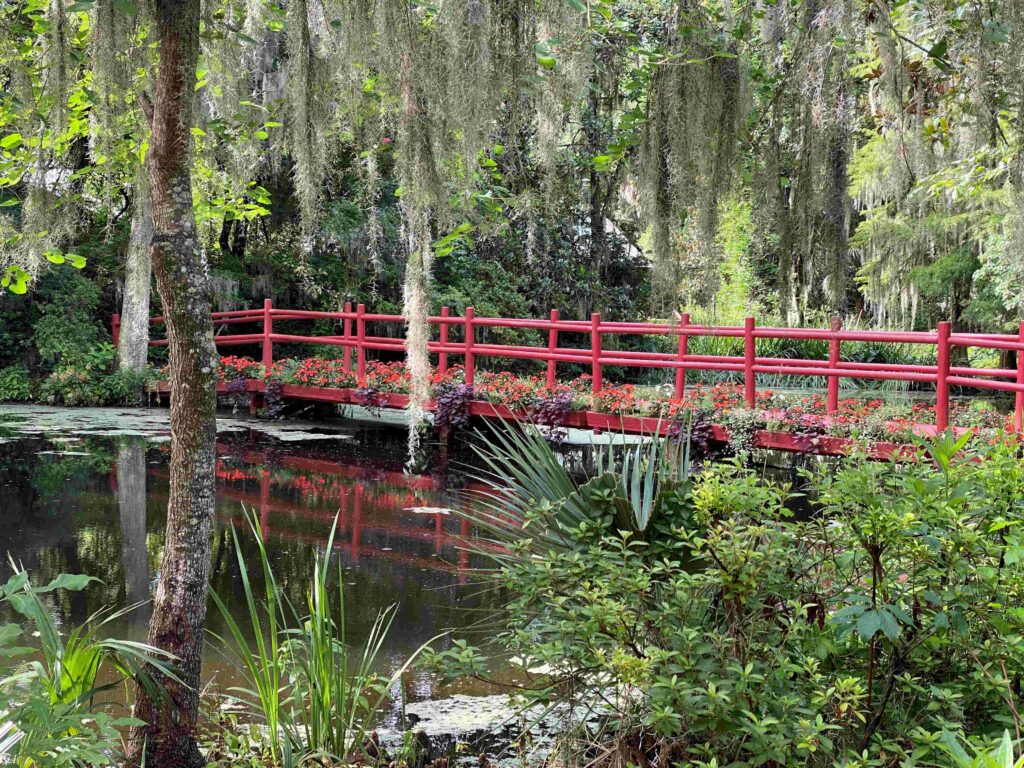By Pat Foster-Turley Ph.D.
July 29, 2021

It’s a bit far for a day trip but if you are in the Charleston region Magnolia Plantation and Gardens is an interesting place to visit. It’s a theme park garden type of place featuring an old plantation house, former slave houses, and lots of gardens merging into natural landscapes of swamps, ponds, forests and the remains of a large rice field. A general admission of about $20 provides access to much of the area but additional fees of around $10 each are needed to visit inside the house, to take a boat or tram tour and to walk on paths and boardwalks through a swamp. Lots of wildlife is found here, but as with all wildlife viewings, it’s a combination of luck and keen observation skills needed to find them.
When my friend Betty Duckworth and I visited the place recently we would have been better off just paying the general admission and skipping the add-ons. But I love swamps and convinced Betty to visit the Audubon Swamp and likewise, she wanted to get an overview of the area from the tram. So off we went to explore with our receipts for payment that no one ever looked at on the tram or in the swamp. In fact, when we parked in the swamp parking lot we were the only ones there besides a delivery truck. And this truck obscured the entrance so we entered instead on an unmarked trail, the exit it turns out, hoping it was the correct place.

We did see lots of giant red swamp hibiscus flowers and, with the guidance of the truck driver we met going the right way on the trail, we saw a well-camouflaged water moccasin right beside the path. And I was happy to see the native tupelo trees, but all in all I’ve been on many other swamp walks elsewhere that did not cost $10.
And the tram was something else too. We patrons sat patiently in our chosen seats waiting for fifteen minutes or so until the driver showed up. And then he emptied and unhooked the last cars and crammed all of us together on the front seats. Bummer. And it got stranger from there. The driver was a local guy, full of himself, talking about his tattoos that included the state tree (sabal palms) and bragging about his wildlife spotting skills and the years he had been leading tours here. “There are a lot of alligators here, but rest assured I will see them before you.” Right.
Soon after a little girl’s voice pipped up from the back car, “I see an alligator” and sure enough there one was, big as life, but the tour guide never saw it. Another guest spotted another one, and the driver tried to back up the train of cars so more people could see it, but he had great difficulty with this maneuver, which almost caused the train to jackknife in the middle. Great.
And then the guide continued on with his fixed prattle about the kinds of owls found in the woods that we were passing through. “Barred owls, barn owls and screech owls live here but you will never see them”. Right. Another little voice pipped up, “There’s an owl!” Sure enough a barred owl was sitting on a branch right near us. The driver didn’t see this either but was afraid at this point to try to back up again. I yelled out to the other visitors, “It’s a young barred owl” but the guide said nothing. It wasn’t very far from there that yes, another owl was spotted by the guests but not by the driver, naturally. And on we went.

The general admission price of $20 however seemed like a fair price for all the other activities included. We admired the “romantic style gardens” their signature look. Various plantings were added to the natural vegetation and some spots were indeed beautiful. But I couldn’t help thinking that this was just a fancy term for letting things grow back to nature. We also ducked into the conservatory full of tropical (but unlabeled) plants to avoid a sudden rainstorm and admired the many unidentified flowers. I wish we had more time to visit the maze, the zoo of native animals, the peacock garden and other areas included in general admission, but after all Charleston was our goal, not this theme park, so we moved on.
Although I am giving it a mixed review here, the Magnolia Plantation and Gardens does have a lot going for it, and in spring when the azaleas and camellias are in bloom and when the swamp provides a rookery for herons, egrets and other water birds it must be magnificent. If you are in the Charleston area and tired of historical homes, give it a try.
Pat Foster-Turley is a zoologist on Amelia Island. She welcomes your nature questions and observations. [email protected]
